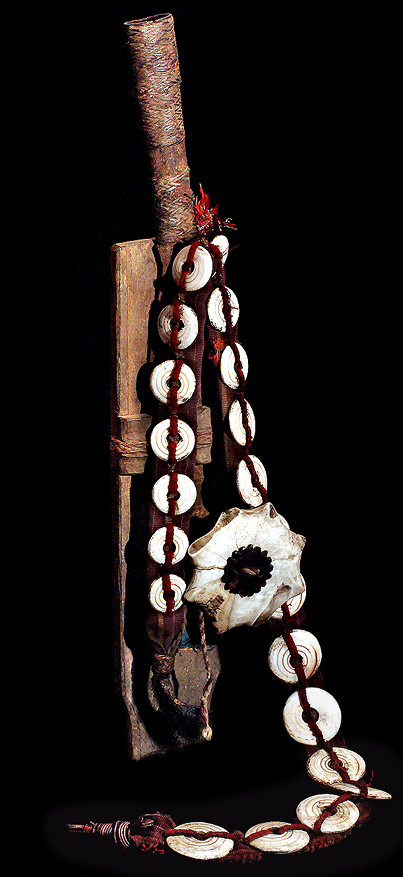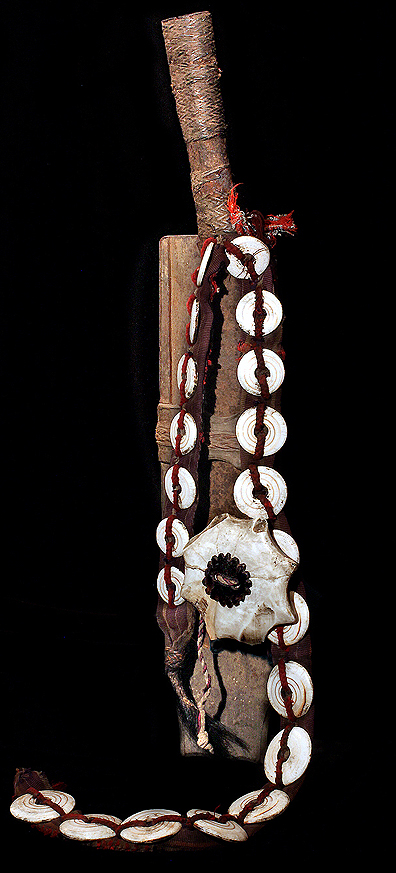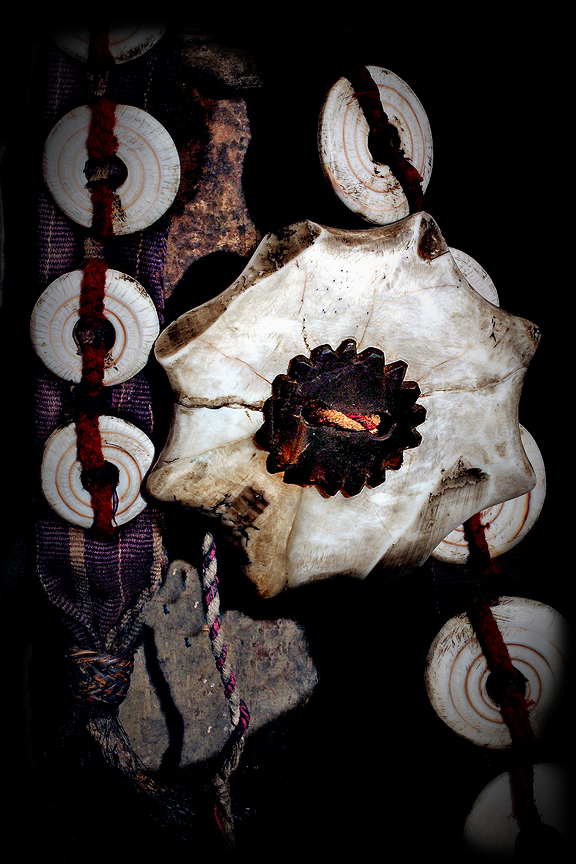IFUGAO
TRIBE:
"GINUTTO" HAND CARVED
SHELL
CEREMONIAL
BELT,
HAND
FORGED "BOLO" MACHETE
AND HAND CARVED WOODEN
SHEATH #2
|
|










 IFUGAO
TRIBE: "GINUTTO" HAND CARVED SHELL
IFUGAO
TRIBE: "GINUTTO" HAND CARVED SHELL
CEREMONIAL BELT, HAND FORGED "BOLO" MACHETE
AND HAND CARVED WOODEN SHEATH #2
IFUGAO TRIBAL USED
WARRIOR’S CEREMONIAL RITUAL GINUTTO SHELL BELT, HAND FORGED “BOLO”
MACHETE, HAND CARVED WOODEN SHEATH, HAND CARVED SHELL; DECORATED IN
BOAR HAIR, A COILED COPPER CLASP, IFUGAO TRIBAL WOVEN TEXTILE, HAND
WOVEN RATTAN AND HAND CARVED COCONUT SHELL CIRCULAR HIGHLIGHT ON THE
LARGEST HAND CUT SHELL! THIS REMARKABLE PIECE COMES FROM THE HEAD
HUNTING TRIBE: "IFUGAO" IN THE CORDILLERA MOUNTAINS ON THE ISLAND
"LUZON" IN THE PHILIPPINES. THIS RARE AND UNUSUAL PIECE HAS A FINE,
RICH, DARK, BROWN PATINA ON THE HAND CARVED WOODEN SHEATH THAT MEASURES
16 INCHES LONG. THE HAND FORGED BOLO MACHETE IS DECORATED IN HAND WOVEN
RATTAN AND IT MEASURES 20 INCHES LONG. WHEN THE MACHETE IS IN THE
SHEATH THE OVERALL LENGTH OF THE MACHETE AND THE SHEATH IS 23 INCHES
LONG. THE TEXTILE BACKED HAND CARVED CIRCULAR SHELL BELT MEASURES 44
INCHES LONG; TERMINATES IN A RATTAN WOVEN BOAR HAIR DECORATION ON ONE
END AND ON THE OTHER END IT TERMINATES IN A COPPER COILED WIRE CLASP
HOOK. THIS IS AN EXTRAORDINARY PIECE OF OLD IFUGAO TRIBAL ART! IT IS IN
GOOD ORIGINAL CONDITION; WITH RUST ON THE BOLO BLADE AND A FEW CRACKS
IN ONE SHELL! THIS PIECE SHOWS ACTUAL SIGNS OF IFUAGO RITUAL USE.
A
“ginutto” ceremonial belt is worn by Ifugao warriors during tribal
rituals. It is made of hand carved disk shape sea shell rings. It is
worn attached to a sheathed bolo knife or machete in its’ wooden
sheath. The shells are attached together by using a combination of
cotton thread, bark thread, tribal textile and rattan. One large hand
carved shell is attached at the middle where a tie holds the whole
ornament to the scabbard on the belt to the waist. It is a highly
valued possession among the Ifugao. Only the propertied elite wear a
ginutto during tribal ceremonial rituals. Ginutto are considered tribal
heirlooms. The traditional tribal materials used to make ginutto belts
are no longer available which makes old original ginutto belts
extremely rare and valuable.
"PUNAM-HAN"
are
used for rice rituals by Shamans for planting and
harvest rituals; where the blood of butchered animals are pored over
the outside and grains of rice are put inside as offering to the Ifugao
gods thus it is regarded
as a sacred tribal ritual object.
A
Bulul is a carved wooden figure used to guard the rice crop by the
Igorot peoples of northern Luzon. The sculptures are highly stylized
representations of ancestors, and are thought to gain power from the
presence of the ancestral spirit. The Ifugao are particularly noted for
their skill in carving bululs. Bululs are used in ceremonies associated
with rice production and with healing. Creation of a bulul involves
a ritual by a priest to ensure that the statue gains power.
The bulul is treated with care and respect to avoid the risk of the
spirits of the ancestors bringing sickness. The figures are placed in
rice granaries to bring a plentiful harvest. A large granary may need
two bululs, and a wealthy noble may also have one or more bululs in his
house. Male and female Bulul statues are often found together, with
sex-related symbols such as the mortar for the female and pestle for
the male. A male bulul may sometimes be decorated with a g-string, and
a female with a waist cloth, earrings and anklets. Although the form
varies, the bulul is commonly represented as seated on the ground, with
arms crossed over his upraised knees. The bulul has a simplified form,
and is traditionally carved from narra or ipil wood or sometimes stone.
The bulul is touched by hands dipped in blood of a chicken or pig in
ritual called tunod during the rice planting season. Over time the
blood imparts a dark color to the figures, overlaid with a patina of
grease from food offerings. Bululs are handed down to the first child
of a family. Typically the older statues have beetle holes made by
insects in the granary.
Ifugao
culture revolves around rice, which is considered a prestige
crop. There is an elaborate and complex array of rice culture feasts
inextricably linked with taboos and intricate agricultural rites, from
rice cultivation to rice consumption. Harvest season calls for
grandiose thanksgiving feasts, while the concluding harvest rites
"tungo" or "tungul" (the day of rest) entail a strict taboo of any
agricultural work. Partaking of the rice wine (bayah), rice cakes, and
'moma' (mixture of several herbs, powdered snail shell and betel nut/
arecoline: and acts as a chewing gum to the Ifugaos) is an indelible
practice during the festivities and ritual activitiess. their retual
and Agricultural terracing is their principal means of livelihood along
with farming. Their social status is measured by the number of rice
field granaries, family heirlooms, gold earrings, carabaos (water
buffaloes), as well as, prestige conferred through time and tradition.
The more affluent, known as kadangyan were usually generous by nature,
giving rice to poor neighbors in time of food shortage(s) and/or
hardship(s). Furthermore, their culture was known for their legal
system, using one of the world's most extensive oral legal traditions
specifying the offense depending on the use of custom law; trial by
elders (influenced in part by public opinion); or trial by ordeal. The
wealthy
were subjected to greater fines than the poor.
Untouched
by the influences of Spanish colonialism, Ifugao culture
value kinship, family ties, religious and cultural beliefs. They're
unique among all ethnic groups in the mountain province, not only for
their interesting customs and traditions but also for their narrative
literature such as the hudhud, an epic dealing with hero ancestors sung
in a poetic manner. Another feature unique to the Ifugao is their
woodcarving art, most notably the carved granary guardians bului and
the prestige bench of the upper class, the hagabi. Their textiles
renowned for their sheer beauty, colorful blankets and clothing woven
on looms. Houses were well-built, characterized by as a square with
wooden floors, windowless walls, and pyramidal thatch roofs. Elevated
from the ground by four sturdy tree trunks, they feature removable
staircases that were hoisted up at night to prevent entry by enemies
and/or wild animals. Lastly, their attire remain traditional for male
Ifugaos, donning the wanno or g-string; there are six types of wanno
which are used depending on the occasion or the man's social status.
Ifugao women, on the contrary, wear tapis, a wraparound skirt; there
are five
kinds of skirts worn, depending on the occasion.
|
THE IFUGAO
TRIBE, ON THE ISLAND: LUZON
IN THE PHILIPPINES, USE
"PUNAMHAN"
HAND CARVED WOODEN BOXES
THAT ARE
"ACTIVATED" THROUGH RITUAL
ANIMAL
BLOOD SACRIFICE.
THE IFUGAO; ORIGINALLY REFERRED TO AS "IGOROTS" WERE
ONCE THOUGHT TO BE INCLUDED WITH THE BONTOC, KALINGA
KANKANAY, IBALOI AND GADDANG AS A SINGLE TRIBE!
IT WAS NOT UNTIL EXHAUSTIVE RESEARCH LATER REVEALED
THESE WERE INDIVIDUAL TRIBES WITH DISTINCT
CULTURAL DIFFERENCES AND BELIEF SYSTEMS!
|
Asian tribal art, artifacts, ifugao, kalinga, bontoc,
asmat, dayak, philippines, asia, head hunters, human trophy skull,
skulls, african, antiques, naga, necklace, headdress, head hunting
trophy skull, Indonesia, Indonesian, SOUTHEAST ASIA, Borneo, Sarawak,
ANTIQUES, Kalimantan, Sulawesi, ART, Sumatra, Timor, ARTIFACTS, Bali,
Java, INDIA, Flores, Sumba, NEPAL, Savu, Roti, BABAS, Lombok, Malaysia.
HOLY MEN, Nusa Tengara, New Guinea, SHAMAN, Irian Jaya, Moluccas,
CONTEMPORARY ART, Tanimbar, Leti, OLD, Lembata, Alor, MINILA,
Philippines, Luzon, PALAWAN, Mindanao, Sulu, BLOW GUN, Southeast Asia,
Asia, NOSE RING, Asian, Burma,
HAT, Myanmar, India, SWORD, Nagaland, Nepal, KNIFE, Tibet, Himalaya,
MOUNTAIN, Himalayan, Assam, TRIBES, Thailand, Vietnam, YAO, Yunnan,
Hainan, HMONG, China, Central Asia, ZAO, Dayak, Batak, BAG, Toraja,
Naga, POLE, Chin, Li, QUIVER, Miao, Bahau, MASK, Punan, Penan, MODELED
SKULL,
Modang, Kayan, BRASS COIL, Kenyah, Ngaju, COILS, Kontu, Kantu, TEXTILE,
Iban, Maloh, PRIEST, Tunjung, Busang, RITUAL, Aoheng, Dong Son,
MYSTICAL
Konyak, Tangkhul, MYSTIC, Ao, Angami, PRIMITIVE, Sema, Wancho,
HAND MADE, Bontoc, B'laan, ARTIST, Bagabo, Gaddang, BULUL, Ifugao.
Sculpture, BULULS, statue, mask, BOX, beadwork, bead, AUTHENTIC,
textile,
weaving, TRIBAL, costume, hat, WOODEN, shield, spear, WOOD, helmet,
sword, BOAR, charm, fetish, FEATHERS, drum, basket, FEATHER, basketry,
jewelry, SILVER, ornament, weapon, ASMAT Canoe, amulet, decoration,
SCULPTURAL,
architecture, architectural, SCULPTURE, longhouse, headhunter, SKULL,
headhunting, shaman, TRIBAL, festival, ceremony, ceremonial, SHAMAN
ritual, tattoo, HEAD HUNTER Skull, dragon, hornbill, HEADDRES, art,
tribal,
VIETNAM, tribe, culture, TRIBES, cultural, myth, TRIBAL, artifact,
artefact, REAL, wood, stone, HAND WOVEN, cotton, metal, CAST bronze,
brass,
cloth, ISLAND, tropics, tropical, EQUATOR, ethnographic, EQUATORIAL,
Tribal Art, Primitive Art, Ethnographic Art, Oceanic Art, Folk Art,
Ethnic Cultures, AUTHENTIC Artifacts, Textiles, ANCIENT, Costumes,
Sculpture, SCULPTURES, Masks, Beadwork, BEADS, Fetishes, Charms, GOLD
Jewelry, Baskets, BAMBOO, Weapons, Shields, ORNATE, Indonesia, Borneo,
PUPPETS,
Sumatra, Sulawese, SHADOW PUPPET, Java, Bali, CAVE, Timor, Flores,
ISLAND, Sumba. Lombok, VILLAGE, Molucca, Philippines, RICE TERRACE,
Luzon,
Mindanao, DAVID HOWARD PHOTOGRAPHY, Nepal, Burma, SACRED JOURNEY:
THE GANGES TO THE HIMALAYAS, Thailand, THE LAST FILIPINO HEAD HUNTERS,
Laos,
Vietnam, TEN SOUTHEAST ASIAN TRIBES FROM FIVE COUNTRIES, India, Central
Asia,
NECKLACES, Southeast Asia, Dayak, STATUE, lban, Kayan, INK STAMP,
Kenyah, Modang, FEATHERED, Bahau, Ngaju, HORSE, Batak, Toraja,
NAGALAND,
Naga, Dong Song. TRIBAL ART, AUTHENTIC PRIMITIVE ART, OLD ETHNOGRAPHIC
ART, RARE OCEANIC ART, BEAUTIFUL FOLK ART, ETHNIC CULTURES,
TRIBAL
ARTIFACTS, TEXTILES, ASIAN, COSTUMES, SCULPTURE, WOOD MASKS, BEADWORK,
CHARMS,
FETISHES, SIVER JEWELRY BOXES, BASKETS, WEAPONS, FILIPINO SHIELDS,
INDONESIA, BORNEO, ETHNOGRAPHIC, SUMATRA, SULAWESE, TRIBAL, JAVA,
BALI, TRIBES, TIMOR, FLORES, ASIAN, SUMBA. LOMBOK, TRIBES, MOLUCCA,
PHILIPPINES, TRIBAL, LUZON, ASIAN, MINDANAO, NEPAL, ASIA, BURMA,
THAILAND, TRIBAL,
LAOS, VIETNAM, TRIBES, INDIA, CENTRAL TRIBAL ASIA, ARTIFACTS, SOUTHEAST
ASIA, HEAD HUNTER, DAYAK, ASIAN, IBAN, KAYAN, TRIBE, KENYAH, MODANG,
TRIBAL,
BAHAU, NGAJU, ASIAN, BATAK, TORAJA, TRIBE, NAGA, tribal art, ASIAN,
primitive art, ASIA, ethnographic art, TRIBAL, oceanic art, ASIAN
folk art, SOUTHEAST ASIA ethnic cultures, artifacts, ASIAN, textiles,
costumes,
VILLAGE sculpture, masks, TRIBAL beadwork, fetishes, TRIBES charms.
jewelry, TRIBE, baskets, weapons, TRIBAL, shields, indonesia, ASIAN,
borneo. sumatra, TRIBAL ART sulawese, java, HILL TRIBE, bali, timor,
ASIAN,
flores, sumba, TRIBES, lombok, molucca, BULUL STATUES philippines,
luzon, ISLAND ART, mindanao, nepal, ASIA, burma, thailand, JOURNEY
laos, vietnam, TRIBAL, india, central asia, TRIBE, southeast asia, OLD
ART, dayak. lban, TRIBES, kayan, kenyah, ASIAN, modang, bahau,
AUTHENTIC
TRIBAL ART, ngaju, batak, HEADDRESS, toraja, naga, MOUNTAIN PROVINCE,
dong
song, KALINGA, Indonesia, Indonesian, IFUGAO, Borneo, Sarawak,
BONTOC, Kalimantan, Sulawesi, TRIBAL, Sumatra, Timor, ASIAN, Bali,
Java, OLD TRIBAL ART
David Howard, art, artist, photography, photographic,
photographs,
print, prints, director, producer, exhibitions, exhibits, exhibit,
painting, paint, studio, studios, etching, silkscreens, silkscreen,
contemporary art, Pop Art, artist's story, journal, video, videos,
documentary, documentaries, books, book, asian, asia, Filipino,
Philippines, Sacred Journey, author, The Last Filipino Head Hunters,
collections, collectables, collectable, archives, archive, art, fine,
contemporary, video, dvd, documentary, Keith Haring, Nam June Paik,
Christo, Lowell Nesbitt, Lawrence Ferlinghetti, Charles Arnoldi,
artists, studio visit, artist, program, sculpture, painting,
photography, prints, print,
photo, paintings, sculptures, keith haring, christo, david howard, nam
june
paik, artseen, videos tape, programs, documentaries, arts, world, san
francisco,
new york, los angeles
ANDY WARHOL,
JOSEPH ALBERS, ELLSWORTH KELLY, CLAES
OLDENBURG,
ROBERT MOTHERWELL, FRANK STELLA, JAMES ROSENQUIST, ROBERT RAUSCHENBURG,
KEITH
HARING, CHRISTO, ROBERT INDIANA, ROY LICHTENSTEIN, ROBERT MAPPLETHORPE,
ALICE
NEAL, ARTISTS, ART, ARTIST, PAINTING, SCULPTURE, PHOTOGRAPHY, SITE
SPECIFIC,
NAM JUNE PAIK, KENNY SCHARF, LOWELL NESBITT, LAWRENCE FERLINGHETTI,
ARMAN
ARMAN, CHARLES ARNOLDI, CHRIS BURDEN, ART STUDIOS, VIRTUAL REALITY,
ABSTRACT
EXPRESSIONISM, PRINT MAKING, ETCHING, PAINTING, HOLOGRAPHY, AFRICAN
ART,
WOODCARVING, MURAL. MURALS, COMPUTER ART, FIGURATIVE EXPRESSIONISM,
IMPRESSIONISM,
MULTI-MEDIA, MULTI MEDIA